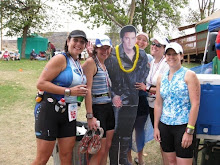Seattle Examiner
There's a lot of buzz around core training for triathlon, and frankly just about every other activity outside of sleeping! But exactly what is the “core” and why is core strength and stability so important for triathlon?
The core is everything between your head and your hips and includes big and small muscles. The core muscles stabilize the spine and pelvis and drive the arms and legs. Many fitness classes, online articles and exercise libraries focus on the abdominal muscles for core training. While the abdominal muscles, (specifically the transversus abdominus, rectus abdominus, internal and external obliques) play an important role, they’re only part of the core story. The muscles in the back, pelvic floor and hips are also crucial to core strength and stability.
Core strength is important during swimming, biking and running for power transfer (between arms and legs) and for stabilization. In swimming, a weak core can cause “fishtailing,” where the hips and legs wiggle from side to side. This extra drag slows you down in the water. A cyclist with poor core strength may have a lot of side-to-side rocking in the shoulders and hips. This extra movement is not only inefficient, it also puts extra wear and tear on the joints, which could, over time, lead to injury. Runners with a weak core often have a drop in the hip during the recovery phase. This is the cause of many running injuries.
Poor core strength results in a loss of power in all three sports and could lead to injury. Incorporate core training 2-3 times a week as part your training program for faster race times and to stay injury free. Here are two excellent exercises to improve and maintain your core strength and stability.
Contra lateral limb raises (aka bird-dog)
Objective: train the body how to stabilize the low back while the arms and legs are moving.
The core is everything between your head and your hips and includes big and small muscles. The core muscles stabilize the spine and pelvis and drive the arms and legs. Many fitness classes, online articles and exercise libraries focus on the abdominal muscles for core training. While the abdominal muscles, (specifically the transversus abdominus, rectus abdominus, internal and external obliques) play an important role, they’re only part of the core story. The muscles in the back, pelvic floor and hips are also crucial to core strength and stability.
Core strength is important during swimming, biking and running for power transfer (between arms and legs) and for stabilization. In swimming, a weak core can cause “fishtailing,” where the hips and legs wiggle from side to side. This extra drag slows you down in the water. A cyclist with poor core strength may have a lot of side-to-side rocking in the shoulders and hips. This extra movement is not only inefficient, it also puts extra wear and tear on the joints, which could, over time, lead to injury. Runners with a weak core often have a drop in the hip during the recovery phase. This is the cause of many running injuries.
Poor core strength results in a loss of power in all three sports and could lead to injury. Incorporate core training 2-3 times a week as part your training program for faster race times and to stay injury free. Here are two excellent exercises to improve and maintain your core strength and stability.
Contra lateral limb raises (aka bird-dog)
Objective: train the body how to stabilize the low back while the arms and legs are moving.
- Come onto your hands and knees on an exercise mat or floor with your hands directly under your shoulders and knees directly under your hips.
- Engage your core muscles (abdominals, back and pelvic floor muscles) so your spine is in a neutral position.
- Raise your left leg and straighten your left while simultaneously raising your right arm. Your right arm and left leg should be parallel to the floor. Keep your neck in neutral alignment with the rest of your spine and nose pointed down at the floor.
- Keep both hips and shoulders parallel to the floor and keep your core engaged while you lower your left leg and right arm back to the starting position and repeat with the opposite limbs.
- Lie on your stomach with your arms bent, elbows close to your sides, palms down, legs straight and toes tucked under.
- Contract your core and slowly lift your torso off the mat, keeping your legs straight and your torso stiff. Make as straight a line as possible from the crown of your head down to your ankles. Avoid sagging in your low back, hiking your hips upwards or bending your knees. Keep your shoulders directly over your elbows. Continue to breathe and hold this position for 5 seconds or more.
- Maintain a stiff torso and straight legs while lowering your body back down to the mat.
- Relax a few seconds, then repeat.
- Work up to holding the plan for 45 seconds, doing 3 repetitions.





















No comments:
Post a Comment